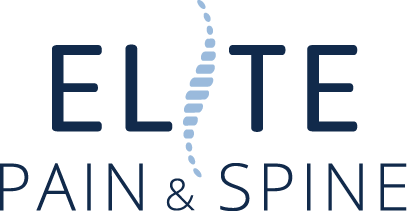Services
Elite Pain & Spine values the well-being of every patient that entrusts us with their care. Our team is determined to listen to patients and find solutions to increase their function and activity level plus decrease chronic pain. We want our patients to be their personal best.
Steroid Injections
What are Epidural Steroid Injections?
Steroids are powerful anti-inflammatory medications that deliver fast relief from swelling and related pain. Your epidural space is the area in your spine between your vertebral wall and the dural sac that surrounds your nerves as they travel through your spine. Your epidural space is filled with blood vessels and fatty tissue that cushion and protect your spinal cord.
An epidural steroid injection delivers a potent anti-inflammatory to your epidural space to reduce swelling that compresses your spinal cord and causes pain and other disruptive symptoms.
What Conditions Can an Epidural Steroid Injection Treat?
The physicians at Elite Pain & Spine recommend epidural steroid injections to relieve pain caused by a wide range of injuries and conditions, including:
- Herniated discs
- Degenerative disc disease
- Spinal stenosis
- Bone spurs
- Spondylolisthesis
- Ligament damage
While an epidural steroid injection doesn’t heal the underlying cause of your pain, it typically provides pain relief to keep you comfortable while you go through additional treatments to heal your body. For example, you’ll get more out of physical therapy if you’re not in severe pain.
What Happens During an Epidural Steroid Injection?
Epidural steroid injections are a minimally invasive, outpatient procedure. You lie on your side on an X-ray table. Your doctor prepares you for the injection with a local anesthetic at your injection site. You stay awake throughout the procedure, although you might be given a mild sedative to keep you relaxed and comfortable.
Then using a fluoroscope, a special type of X-ray, your doctor inserts a needle into the epidural space of your spine. They inject a combination of a numbing agent and a steroid. The numbing agent provides immediate relief while the steroid takes effect. You might feel some pressure during the injection, but the local anesthetic should prevent you from feeling any pain.
What Should I Expect After an Epidural Steroid Injection?
While you can get up and walk around right away, you’ll spend 15-20 minutes in a recovery room after your injection so your doctor can observe you as your local anesthetic wears off. The steroid can take up to three days to reduce the swelling in your spine and ease or eliminate your pain.
Call Elite Pain & Spine to find out if epidural steroid injections are right for you.
Nerve Blocks
What is a Nerve Block?
A nerve block is an injection therapy that delivers medications to one or a group of nerves to ease or eliminate pain.
The medications used in the treatment include a local anesthetic to disrupt the pain signals that travel to your brain. You can also receive anti-inflammatory medicines to reduce inflammation that could be contributing to your pain.
What Conditions Can Nerve Blocks Treat?
The medical staff at Elite Pain & Spine can recommend the type of nerve block you need based on the severity and cause of your pain.
Nerve blocks can address chronic pain resulting from injuries or underlying disease that affect your:
- Face
- Arms
- Neck
- Back
- Legs
- Buttocks
To determine if you’re a good candidate for a nerve block, your Elite Pain & Spine specialist reviews your medical history and your condition. They could suggest a nerve block when other treatments, including medications and physical therapy, aren’t effectively relieving your pain.
What Can I Expect During a Nerve Block Procedure?
The medical team at Elite Pain & Spine perform in-office nerve blocks on an outpatient basis. To keep you comfortable, your provider can give you a mild sedative before the injection.
To ensure the injection goes in the right place, your doctor uses fluoroscopy, an X-ray technology that provides real-time images of your inner structures.
Following your injection, you remain in recovery for a period of time to allow the medication to take effect. You’ll need a ride home if you were sedated for the procedure.
Side effects of nerve blocks are minimal, with some risks involving injection site infections, bleeding, and/or soreness.
How Long Do the Effects of a Nerve Block Last?
Everyone responds to nerve block treatments differently. In some cases, you can expect to achieve pain relief that lasts several weeks.
To help you maintain your pain-free results, your Elite Pain & Spine doctor will recommend additional nerve blocks along with other therapies, including medication and/or physical therapy.
If you’re looking for a minimally invasive solution to treating chronic pain, schedule a consultation at Elite Pain & Spine to find out more about the benefits of nerve blocks.
Nerve Ablations
What is Nerve Ablation?
Nerve ablation — also called radiofrequency ablation — is a minimally invasive treatment that uses heat to destroy the nerve fibers responsible for sending pain signals to your brain. The physicians at Elite Pain & Spine use nerve ablation to ease or eliminate back and neck pain as well as arthritic joint pain.
Radiofrequency ablation provides a range of benefits, including a reduced need for surgery, a rapid recovery, and decreased dependence on pain medication.
What Happens During Nerve Ablation?
Nerve ablation is a three-step process — preparation, needle insertion, and electrical current delivery. The whole process takes 15-45 minutes, depending on the number of nerves that are needed to be treated.
You stay awake during the procedure but your physician uses a local anesthetic to thoroughly numb the treatment area. They can offer you a mild sedative to help you stay calm and relaxed throughout the procedure.
They use a fluoroscope to provide real-time images as they insert a thin, hollow needle into the precise site of the malfunctioning nerve. You could feel some pressure when your doctor inserts the needle, but the local anesthetic should ensure you don’t feel any pain.
When the needle is in place, your physician sends a radiofrequency current through the needle for about 90 seconds. The current converts to heat and makes a small and precise burn on your nerve called a lesion. The lesion disrupts the pain signals produced by that nerve.
What Should I Expect After a Nerve Ablation Treatment?
In most cases, nerve ablation may provide immediate pain relief, and you can get up and walk around as soon as your procedure is done. In many cases, it may take up to a few weeks. You will spend a little time in a recovery room so your doctor can observe you as the anesthetic wears off. You could have some tenderness at your injection site, but in most cases, you should be back to your regular activities within 24-72 hours.
Am I a Good Candidate for Nerve Ablation?
If you have chronic nerve pain or have had successful pain relief from a nerve block, nerve ablation could be right for you. The physicians at Elite Pain & Spine provide thorough exams and testing to ensure that nerve ablation will ease or eliminate your pain and help you get back to a healthy and active life.
If you’re interested in nerve ablation and want to know if it’s right for you, call Elite Pain & Spine today.
Kyphoplasty
What is a Kyphoplasty?
Kyphoplasty is a surgical procedure to treat vertebral compression fractures. It can reduce pain and increase mobility. It offers a minimally invasive alternative to other surgeries.
This article looks at what the procedure involves, why someone may need it, plus benefits, risks, complications, and recovery.
A doctor may suggest kyphoplasty to a person with a vertebral compression fracture.
Kyphoplasty is a vertebral augmentation surgery to treat fractures in the vertebra. These fractures may occur because of conditions such as osteoporosis or trauma.
Vertebroplasty is a similar technique. Both procedures involve injecting acrylic bone cement into the fracture through a hole in the skin.
The difference between the two techniques is that kyphoplasty also attempts to address curvature of the spine to restore height. This involves inflating a small balloon in the vertebra to create space before injecting the bone cement. Some doctors refer to this procedure as balloon kyphoplasty.
Why is it needed?
A surgeon may perform kyphoplasty for a vertebral compression fracture (VCF). VCF’s occur when the bony block in the spine collapses, which may cause extreme pain, deformity, and loss of height.
The incidence of VCF’s increases with age and most result from low energy injuries in older people with osteoporosis. However, other possible causes of VCF’s include trauma from car accidents or sports injuries or tumors that have started in the spine or spread to the bones.
According to OrthoInfo from the American Academy of Orthopaedic Surgeons (AAOS), many people who have a VCF recover within 3 months without specific treatment to repair the fracture. Sometimes, a doctor will recommend that a person wears a brace to restrict movement, which helps the fracture to heal.
If a person has severe pain that does not respond to non-surgical treatment, then surgery is an option. A doctor will talk to the individual about the most suitable procedure for them. This will depend on the type of vertebral compression they have.
Procedure
During the days before surgery, a doctor may recommend that a person avoids taking drugs that make it hard for blood to clot, such as aspirin and warfarin. On the day of surgery, a person will probably be told not to eat or drink anything for several hours before the procedure. A person can take any medication a doctor approves, along with sips of water.
A surgeon will perform kyphoplasty in a hospital or outpatient clinic. A person may have either local or general anesthetic. The surgical procedure is as follows:
- A surgeon will insert a needle into the spine bone through the skin. They will then use X-ray images to guide them to the correct area.
- They will then place a small device called a balloon tamp through the needle and into the fractured vertebra.
- The surgeon will inflate the balloon tamp. This helps to restore the height of the vertebrae.
- When the surgeon removes the balloon tamp, it leaves a cavity that is injected with acrylic bone cement to prevent it from collapsing again.
Most people will be able to go home from the hospital the same day. A person should not drive unless a medical professional approves it.
Recovery Time
The AAOS suggest that following surgery, most people can go back to their normal activities of daily living with no restrictions. A person should check with their doctor or surgeon if there are any activities that they should avoid during the recovery period.
A person may feel some soreness in their back where the surgeon inserted the needle, but this will not usually last longer than a few days.
Spinal Cord Stimulation
What is a spinal cord stimulation?
Spinal cord stimulation therapy masks pain signals before they reach the brain. A small device, similar to a pacemaker, delivers electrical pulses to the spinal cord. It helps people better manage their chronic pain and reduce their use of opioid medications. It may be an option if you suffer chronic back, leg or arm pain and have not found relief with other therapies.
What is a spinal cord stimulator?
A spinal cord stimulator (SCS) device is surgically placed under your skin and sends a mild electric current to your spinal cord (Fig. 1). Thin wires carry current from a pulse generator to the nerve fibers of the spinal cord. When turned on, the SCS stimulates the nerves in the area where your pain is felt. Pain is reduced because the electrical pulses modify and mask the pain signal from reaching your brain.
A spinal cord stimulator works by masking pain signals before they reach the brain. A stimulator device delivers electric pulses to electrodes placed over the spinal cord. Modified by the pulses, the pain signals are either not perceived or are replaced by a tingling feeling.
Stimulation does not eliminate the source of pain, it simply interferes with the signal to the brain, and so the amount of pain relief varies for each person. Also, some patients find the tingling sensation unpleasant. For these reasons a trial stimulation is performed before the device is permanently implanted. The goal for spinal cord stimulation is a 50-70% reduction in pain. However, even a small amount of pain reduction can be significant if it helps you to perform your daily activities with less pain and reduces the amount of pain medication you take. Stimulation does not work for everyone. If unsuccessful, the implant can be removed and does not damage the spinal cord or nerves.
Some SCS devices use a low-frequency current to replace the pain sensation with a mild tingling feeling called paresthesia. Other SCS devices use high-frequency or burst pulses to mask the pain with no tingling feeling. A paresthesia-free setting is an option on most devices.
Stimulation does not eliminate the source of pain. It simply changes the way the brain perceives it. As a result, the amount of pain relief varies for each person. The goal for SCS is a 50 to 70% reduction in pain. However, even a small amount of pain reduction can be significant if it helps you perform daily activities and reduces the amount of pain medication you take. SCS does not improve muscle strength.
Stimulation does not work for everyone. Some people may find the sensation unpleasant. Other people may not get relief over the entire pain area. For these reasons a trial stimulation allows you to try it for a week. If it doesn’t work for you, the trial wires can be removed, leaving no damage to the spinal cord or nerves.
Am I a candidate?
An evaluation of your physical condition, medication regime, and pain history will determine whether your goals of pain management are appropriate for SCS. A neurosurgeon, physiatrist, or pain specialist will review all previous treatments and surgeries. Because chronic pain also has emotional effects, a psychologist will assess your condition to maximize the probability of a successful outcome.
Patients selected for SCS usually have had chronic debilitating pain for more than 3 months in the lower back, leg (sciatica), or arm. They also typically have had one or more spinal surgeries.
You may be a candidate for SCS if :
- Conservative therapies have failed.
- You would not benefit from additional surgery.
- The pain is caused by a correctable problem and should be fixed.
- You do not want further surgery because of the risks or long recovery. Sometimes SCS may be chosen over a large, complex spine surgery.
- You do not have untreated depression or drug addiction; these should be treated prior to having a SCS.
- You have no medical conditions that would keep you from undergoing implantation.
- You have had a successful SCS trial.
SCS works better in the earlier stages of a chronic condition, before a cycle of pain-suffering-disability-pain is established.
An SCS can help lessen chronic pain caused by:
- Chronic leg (sciatica) or arm pain: ongoing, persistent pain caused by arthritis, spinal stenosis, or by nerve damage.
- Failed back surgery syndrome: failure of one or more surgeries to relieve persistent arm or leg pain, but not a technical failure of the original procedure.
- Complex regional pain syndrome: a progressive disease in which patients feel constant, chronic burning pain, typically in the foot or hand.
- Arachnoiditis: painful inflammation and scarring of the protective lining of the spinal nerves.
- Other: stump pain, angina, peripheral vascular disease, multiple sclerosis, or spinal cord injury.




